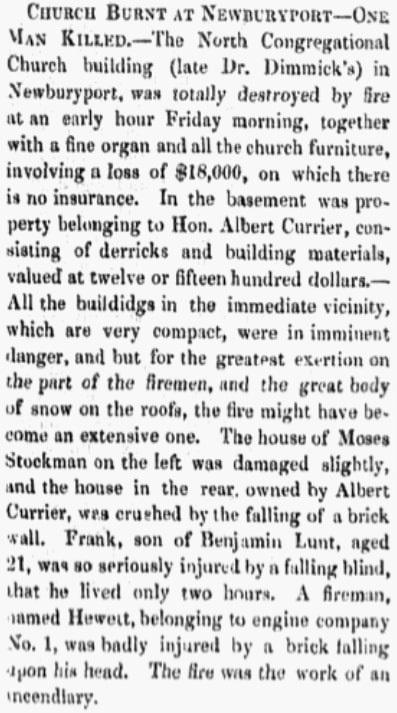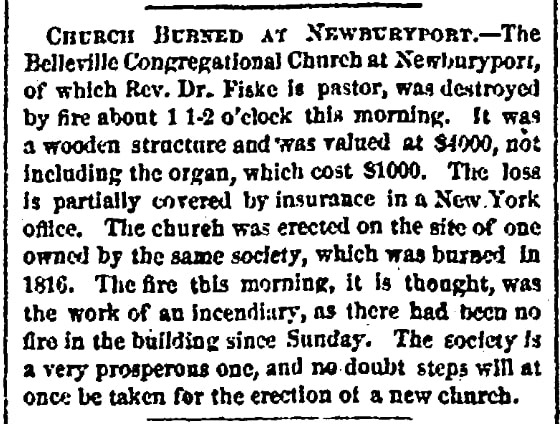Introduction: In this article, Melissa Davenport Berry continues her story about a 19th century arsonist who ravaged Newburyport, Massachusetts – and how he was finally caught. Melissa is a genealogist who has a blog, AnceStory Archives, and a Facebook group, New England Family Genealogy and History.
Today I continue with the story of the infamous arsonist Leonard Choate, aka “Firebug Choate,” who burned homes, barns, and buildings in the town of Newburyport, Massachusetts, in the 19th century (see: Leonard Choate: Newburyport’s Infamous Arsonist ). His fire fury left a trail of terror and a loss of lives. It was estimated that more than 150 structures had been torched by the end of this pyro’s career. It took years to catch him.
Leonard was a ship joiner and served in the Cushing Guards. He came from a prominent, respected family with roots in the community, and no one suspected him to be the incendiary.
On 22 March 1861, the Old North Congregational Church was torched by Firebug Choate during one of the worst blizzards recorded. Last year, an anonymous donor dropped off at the present church a rare photo of the 1861 church shortly after it was burned – with a group of about 30 people standing in front. One can’t help but wonder if Leonard was posing in that photo.

According to the Barre Gazette, one firefighter was killed (a second firefighter died from his injuries two days later) and the damage totaled $18,000 – with no insurance to cover the loss. Items included church furniture, a rare French organ, and portraits of past ministers.
Additionally, the derricks and building supplies located in the church basement belonging to renowned New England builder Albert Currier, valued over $1,200, were destroyed. Currier’s home, located in the rear of the church, was destroyed by a falling brick wall. Moses Stockman’s home was damaged slightly. The saving grace from even greater destruction was due to both “the greatest exertion on the part of the firemen, and the great body of snow on the roofs.”

History columnist and former fire chief, Joe Callahan, published “The burning of the North Church 150 years ago” in 2011. He noted the difficulty the firemen had due to the severe weather conditions.
According to Callahan, the bell in the tower, sold to the church by Paul Revere and cast in London (1795) by John Warner, fell into flames and was melted. Also destroyed was the tower clock that had been purchased in 1785.
Albert Currier, who lost building supplies in the fire, was the man who rebuilt the new structure. It was completed by the following October.
Firebug Choate also burned the Belleville Congregational Church, of which Rev. Dr. Fiske was pastor, on 12 January 1867. The wooden structure was valued at $4,000 and the organ at $1,000.

According to trial records, the First Parish Church of Newbury was burned on 25 January 1868, and other attempts on houses of worship by Firebug Choate were made on both the Harris Street and Congress Street churches.
It was the burning of James Ackerman’s slaughterhouse and barn on 16 January 1868 that ignited clues in bagging the firebug. More on that later, but the whole skinny can be found in the “Massachusetts Reports: Decisions of the Supreme Judicial Court of Massachusetts, Volume 105.”
The confident fire imp Choate was a bit brazen and sent anonymous letters to the authorities bragging about his fire-blazing tactics, and confirmed there would be more ahead once he had secured more spark supplies. One letter postmarked 11 January 1869, sent to the City Marshal Captain William H. Fitts, was used as evidence in Leonard’s trial:
“Capt. Fitts, we are all out of boxes, but we expect a supply soon from Boston, then look out. In firing the old town church, we worked five nights in succession, before we got her a-going. The last night we put three gallons of kerosene on the floor. We crawled underneath the church. A large hole was found on the stonework on the backside sufficient to let a man crawl under. In setting the Belleville afire we used two gallons of kerosene oil, which accounts for the rapid spread of the flames. When the boxes come, look out. Pro Bono Publico.” (Commonwealth v. Leonard Choate)
Stay tuned to find out how Mayor Nathaniel Pierce and Newburyport Herald editor E. L. Colby executed a sting operation – and how one police captain with Yankee pluck doused the Firebug.
Note: Just as an online collection of newspapers, such as GenealogyBank’s Historical Newspaper Archives, helped tell the story of arsonist Leonard Choate, they can tell you stories about your ancestors that can’t be found anywhere else. Come look today and see what you can discover!
Related Article:
